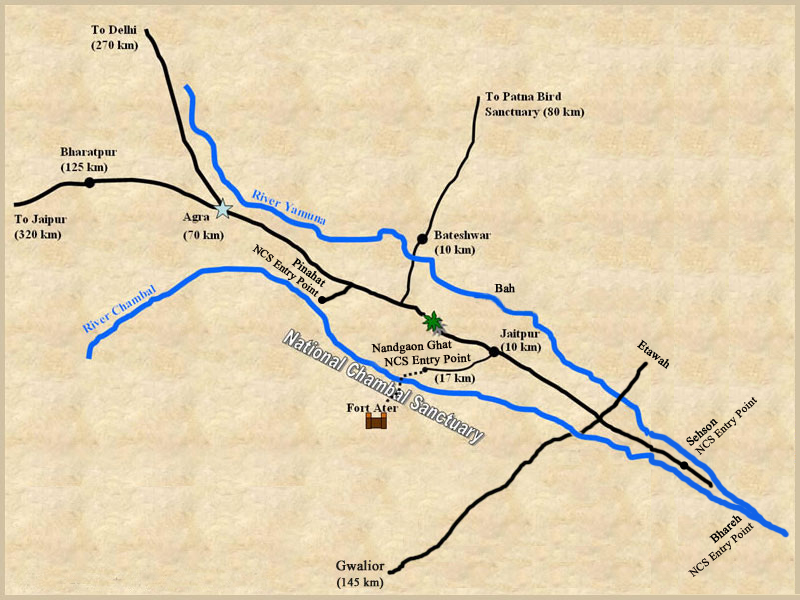Geography
Illegal Sand Mining in National Chambal Sanctuary
- 22 Mar 2023
- 5 min read
For Prelims: National Chambal Sanctuary, Wildlife Protection Act, 1972, Important Bird and Biodiversity Area, Ramsar site, The Mines and Minerals (Development and Regulations) Act, 1957, Sustainable Sand Mining Management Guidelines 2016.
For Mains: Significance of National Chambal Sanctuary, Status of Sand Mining in India.
Why in News?
The area of National Chambal Sanctuary is under threat due to illegal sand mining activities that are damaging the ecosystem and endangering its flora and fauna.
- To tackle this issue, a high-level meeting was held in Jaipur, where the chief secretaries of the three states discussed coordinated efforts to protect the sanctuary.
What is the Significance of National Chambal Sanctuary?
- The National Chambal Sanctuary, located at the trijunction of Rajasthan, Madhya Pradesh, and Uttar Pradesh.
- It is a fragile lotic ecosystem, which is a critically important breeding ground for gharials - fish-eating crocodiles.
- The sanctuary is protected under the Wildlife Protection Act, 1972, and is listed as an ‘Important Bird and Biodiversity Area’.
- The sanctuary is also a proposed Ramsar site, and over 320 species of resident and migratory birds inhabit the area.
What is the Status of Sand Mining in India?
- About:
- Sand is classified as a “minor mineral”, under The Mines and Minerals (Development and Regulations) Act, 1957 (MMDR Act) and administrative control over minor minerals vests with the State Governments.
- Rivers and coastal areas are the main sources of sand, and the demand for it has increased significantly in recent years due to the construction and infrastructure development boom in the country.
- The Ministry of Environment, Forests, and Climate Change (MoEFCC) has issued "Sustainable Sand Mining Management Guidelines 2016" to promote scientific sand mining and environmentally friendly management practices.
- Sand is classified as a “minor mineral”, under The Mines and Minerals (Development and Regulations) Act, 1957 (MMDR Act) and administrative control over minor minerals vests with the State Governments.
- Issues Related to Sand Mining in India:
- Water Scarcity: Sand mining can lead to the depletion of groundwater reserves and cause water scarcity in nearby areas.
- For instance, Yamuna River in Yamuna Nagar district of Haryana is facing severe threat from mechanised and unsustainable stone and sand mining.
- Floods: Excessive sand mining can cause the riverbeds to become shallow, which can increase the risk of floods.
- For example, in the state of Bihar, sand mining has led to increased flooding in the Kosi River, causing damage to crops and property.
- Associated Illegal Activities: Unregulated sand mining also involves illegal activities, such as encroachment on public land, corruption, and evasion of taxs.
- Water Scarcity: Sand mining can lead to the depletion of groundwater reserves and cause water scarcity in nearby areas.
What is the Legislative Framework of Mining Sector in India?
- The entry at serial No. 23 of List II (State List) to the Constitution of India mandates the state government to own the minerals located within their boundaries.
- The entry at serial No. 54 of List I (Central List) mandate the central government to own the minerals within the exclusive economic zone of India (EEZ).
- In pursuance to this Mines & Minerals (Development and Regulation) (MMDR) Act of 1957 was framed.
- International Seabed Authority (ISA) regulates mineral exploration and extraction. It is guided by the UN treaty and India being a party to the treaty has received an exclusive right to explore polymetallic nodules over 75000 sq. km in Central Indian Ocean Basin.
Conclusion
The joint action taken by the three states is a significant step towards conserving the flora and fauna of the sanctuary, protecting the environment and preserving our natural heritage for future generations.
UPSC Civil Services Examination Previous Year Question (PYQ)
Prelims
Q. Consider the following minerals: (2020)
- Bentonite
- Chromite
- Kyanite
- Sillimanite
In India, which of the above is/are officially designated as major minerals?
(a) 1 and 2 only
(b) 4 only
(c) 1 and 3 only
(d) 2, 3 and 4 only
Ans: (d)
Mains
Q. Coastal sand mining, whether legal or illegal, poses one of the biggest threats to our environment. Analyse the impact of sand mining along the Indian coasts, citing specific examples. (2019)





